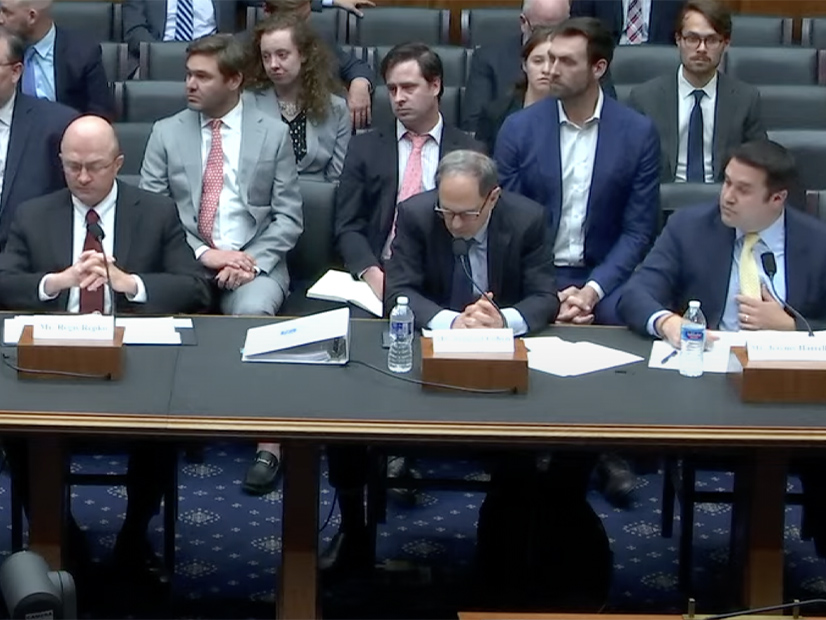House lawmakers heard from nuclear industry experts Tuesday as they get started on legislation aimed at helping the deployment of advanced reactors across the U.S.
“To expand the industry, it is vital we encourage regulatory certainty and make sure our reactor licensing processes enable the safe and broad deployment of nuclear technologies,” said Rep. Jeff Duncan (R-S.C.), chair of the House Energy and Commerce Subcommittee on Energy, Climate and Grid Security. “This is especially important for advanced reactor technologies.”
Nuclear power now provides about 20% of the country’s electricity, including about half of its carbon-free energy, and it can help eliminate emissions on the grid, said the subcommittee’s ranking member, Rep. Diana DeGette (D-Colo.). But several things need to happen for nuclear to remain a key part of the generation mix going forward, she said.
“The United States must develop a comprehensive science-based strategy to dispose of spent fuel — a strategy that does not cause harm to public health or our environment,” said DeGette. “If we don’t have a long-term permanent solution for disposing of nuclear waste, then we will struggle to be able to use this source of carbon-free electricity.”
She said the other key challenge is figuring out what do with the existing fleet, which has seen some scattered retirements in recent years, but only one new nuclear plant coming online: Southern Co.’s Vogtle plant.
Once Vogtle’s units are online, the country will have 94 reactors operating, and it will be important to extend their operating lives while securing them a more stable source of uranium, said Idaho National Laboratory’s Jess Gehin.
“Currently, our nation imports 90% of our uranium needed for our reactor fleet,” Gehin said. “This includes imports from Russia; eliminating these imports from Russia requires us to establish an expanded uranium-enrichment capability domestically and with our close allies.”
Some of the proposed new reactors such as TerraPower’s natrium reactor in Wyoming and X-energy’s Xe-100 planned for deployment at a Dow Chemical facility on the Gulf Coast need a stable, domestic supply of high-assay, low-enrichment uranium that is not produced here at all, said Gehin.
Duke Energy (NYSE:DUK) has the largest fleet of 11 “regulated” nuclear units at its vertically integrated utilities in the Carolinas, and the North Carolina Utilities Commission has approved its early investment to consider building new, advanced reactors, said Regis Repko, the company’s senior vice president of generation and transmission strategy.
“We plan to add unprecedented numbers … of solar energy, storage [and] wind power to the grid as we continue to retire our aging coal fleet,” Repko said. “However, we must have firm, dispatchable resources, such as nuclear and natural gas, to support renewable energy resources. Our customers depend on us, and we must not jeopardize reliability or affordability in this transition.”
Duke’s 11 plants are all set to retire between 2030 and 2046. To avoid losing those plants, which produce half the energy and 80% of the clean energy for its utilities in the Carolinas, the company would like to extend their licenses another 20 years. Duke also plans to build 8 GW of new nuclear power.
The firm plans to work with stakeholders and the Nuclear Regulatory Commission to ensure the licensing process for those new reactors is effective, efficient and in line with the safety of the new reactor designs, Repko said.
The bipartisan support seen at the hearing, recent advances in Europe and California’s decision to extend the life of the Diablo Canyon nuclear plant all point to the increased support the technology has seen in recent years, said Clean Air Task Force Executive Director Armond Cohen.
“The problem is that we’re just not moving at any scale and pace that’s relevant to climate. To be relevant to climate, nuclear is going to have to be churning out something like 100 GW/year globally,” said Cohen. “That’s about in the range of where we were with coal and gas in a sustained way for a few years. We have to be really running at that scale. We’re about 10 GW/year, so, we need to be 10 times where we are.”
To have an impact on global climate change, the U.S. nuclear industry will need to export its technology because domestic emissions only amount to 15% of global emissions, he added.



